Round 1
|
[ CARO-KANN,B13] 1.e4 c6 2.d4 d5 3.exd5 cxd5 4.Bb5+ ? patzer move. 4...Nc6 I like this - avoids exchanges. White gets the worst of the exchange if he plays Bxc6 5.Nf3 Bf5 Novelty, slightly risky as ignores the pin. 6.Ne5 Qd6 ?! inaccurate as White has a later Bf4 possibility after he blocks the Qb4 ch. | ||
| [6...Qb6 ! attacks the Bishop [and puts pressure on d4, b2]] | ||
|
7.Nc3 This cuts out a Qb4 check 7...a6 8.Ba4 ? | ||
|
[8.Bxc6+ ! bxc6
9.Bf4 += with attacking chances, for example... 9...Qb4 10.Qf3 ! Qxd4 | ||
|
(10...Bxc2 11. | ||
|
(10...Qxb2 11. | ||
| 11.Nxc6] | ||
|
8...b5 9.Bb3 ?
loses a pawn. | ||
|
[9.Nxc6 ! Qxc6
10.Bb3 e6 11. | ||
9...Nxe5 10.dxe5
Qxe5+ 11.Qe2 Qxe2+
12.Kxe2 e6 13.f3 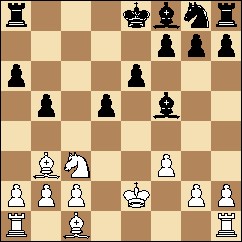 Here Black should stop and think carefully how he should set up his pieces to play this position strategically. 13...Rc8 This puts a Rook on an open file, but does not threaten b4 as we shall see. Moving the Rook from the a file also makes White's later a4 break stronger. 14.Kd2 ? unnecessary | ||
|
[14.Be3 ! playable, since b4 does not work. 14...b4 15.Na4 Bxc2 16.Rac1 d4 ! 17.Bxc2 ! | ||
| (17.Bxd4 Rd8) | ||
|
17...dxe3 18.Nb6
Rd8 19.Ba4+ | ||
14...Bb4 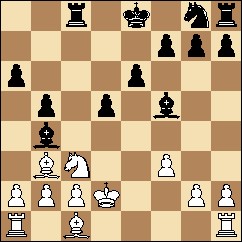 ?! Aims to double the pawns, but is double edged as gifts White the two bishops and the pawns are easily defended. Also having a pawn on c3 enables White to gain counterplay on the a file with a4 ! Black's strategic plan should be to play Bd6 [best post], and play Ne7 to c6 (better than f6). This is the most effective placing of the pieces. 15.a3 Bxc3+ ?! It wasn't too late for Bd6 | ||
| [15...Bd6 !? 16.Kd1 Ne7 17.Ne2 Nc6] | ||
| 16.bxc3 Nf6 | ||
| [16...Ne7 !? 17.a4 Nc6 is better.] | ||
|
17.a4 ! Now White gains play on the a-file. 17... | ||
|
[19.Ra5 ! is better 19...Rb8 20.g4 Bg6 21.Ke2 and the 2 Bishops give White compensation for the pawn.] | ||
|
19...Rc6 ? This is a "nothing"
move, Black is drifting. | ||
| [19...Ra8 ! to challenge the a file, but it's certainly not easy now.] | ||
|
20.Ra5 Rb8
21.Rha1 White has made some progress,
and it's not so easy for Black now. 21...Ne8 | ||
| [21...Nd7 is better. Black should play his Knight to c4. True then Bxc4 gives opposite coloured Bishops ending, but it's lost for White.] | ||
| 22.Ra8 Rcc8 23.Rxb8 Rxb8 24.g4 Bg6 25.Ke3 | ||
| [25.Ra6 !?] | ||
| 25...h6 ? | ||
|
[25...h5 ! makes more sense here 26.h3 Nd6 27.Kd2 | ||
| (27.Ra6 Nc4+ 28.Bxc4 bxc4 wins a pawn.) | ||
| 27...hxg4 28.hxg4 Nc4+ 29.Bxc4 bxc4 is probably won for Black.] | ||
|
26.h3 Nd6
27.Kd2 b4 ?!
undoubling White's pawns and freeing the Queen Bishop. | ||
|
[27...Nc4+ was the alternative. 28.Bxc4 bxc4 29.Ba3 f6 with advantage - a similar ending to earlier line.] | ||
| 28.cxb4 Rxb4 29.Bc3 | ||
| [29.Ra6 !? Nb7 30.Bc3 Rb5 31.Ba4] | ||
| 29...Rb8 | ||
|
[29...Rb6 ! is more accurate. 30.Ra7 Nb5 31.Ra8+ Kh7] | ||
|
30.Be5 Rb6
31.Ra8+ Kh7 The
two Bishops give White good play, and he has full compensation for the pawn minus. 32.Rd8 Nb5 33.Rb8 ? Why ? With Rd7 White is fine. 33...Rxb8 34.Bxb8 Nd4 35.f4 Be4 36.c3 ?? John has trouble with his eyes. He is nearly blind in one eye, and this is a terrible blunder. | ||
| [36.Ba4 g5 37.c3 Nf3+ 38.Ke3] | ||
36...Nxb3+ 37.Ke3
Nc5 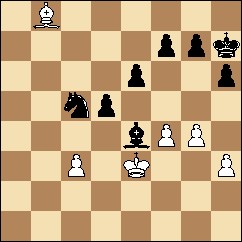 Another inaccurate move as White will be able to play the annoying c4 move after Kd4. The Knight should go to a5. | ||
| [37...Na5 38.Kf2 Nc4 39.Kg3 Kg6 is easy.] | ||
| 38.Kd4 Nd3 39.c4 Nf2 | ||
|
[39...Nb4 is the most accurate as White
cannot get his pawn to c5 e.g. 40.Bd6 | ||
| (40.c5 Nc6+) | ||
| 40...Nc2+ 41.Ke5 f6+ 42.Kxe6 Nd4+ 43.Kf7 dxc4 wins] | ||
40.c5 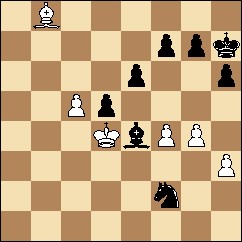 Black has given White a chance with this passed pawn. 40...Bd3 ? puts the win in jeopardy. The calm Bc2 won. | ||
| [40...Bc2 41.c6 Ba4 42.c7 | ||
| (42.Kc5 Ne4+ 43.Kb6 d4 wins) | ||
| 42...Bd7] | ||
| 41.Ke3 Ne4 42.Kxd3 Nxc5+ 43.Kd4 Nd7 44.Bd6 Nf6 45.f5 Ne4 46.Bc7 Nf2 47.fxe6 fxe6 48.Ke5 Nxh3 49.Kxe6 d4 50.Ba5 ?! | ||
| [50.Ke5 !?] | ||
|
50...Kg6 51.Kd5
Kg5 52.Kxd4
Kxg4 Black has managed to achieve yet
another won position. 53.Bc3 Nf2 54.Ke3 ? Nh1 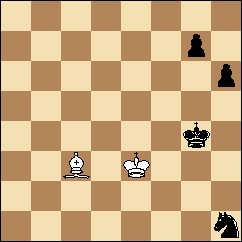 ?? Of course Nd1 instead wins immediately. | ||
| [54...Nd1+ 55.Kd4 Nxc3 56.Kxc3 g5] | ||
| 55.Bxg7 h5 56.Be5 ?! | ||
| [56.Bf6 !?] | ||
|
56...h4 57.Bc7
Ng3 58.Kf2
h3 ?? Another blunder, but the game was
drawn in any case. 59.Bxg3 0.5 - 0.5 | ||